Page 1 of 3
Plywood garboard removal
Posted: Sun May 09, 2010 4:43 am
by 62cruiserinc
In my previous post, I described a boat-flipping fixture. I have now flipped the boat and got a good look at the bottom keel area, where I had previously removed the outer keel and stem. The boat is a 16' 1962 Cruiser Inc.
There appears to be more bad wood and rot than I thought previously. The inside stem wood has split in the area just forward of the stem/keel joint. It also looks pretty black. Also, the area on the stem that has split (about 18 inches long at the lower end) either has pulled apart or had rotted away, leaving a "slot" about 1/8" wide down the center. From inside the boat, the stem didn't appear to be bad and there is no crack showing through. If I put a screwdriver into the slot (on the bottom)and pull sideways, the gap widens and the two plywood garboards push apart.
It looks like I'll have to scarf in a new stem section. Since I will also have to scarf in a new piece on a bunch of ribs (the part near the keel), I am thinking that I should just remove the garboards to make the overall job easier. Then I could inspect the entire keel/sister area along with the rib ends. Since the rib ends are screwed into the keel sisters underneath the plywood, this makes rib end replacement easier.
The plywood garboards seem to be in very good shape, excepts for some minor delamination in a few spots on the top layer inside. It would also be much easier to scarf joints when there is no plywood against the piece being scarfed. Sanding the pieces (plywood, ribs, keel, etc) on allsides and finishing them would also be much easier.
To remove the garboards, it looks like I have to remove the screws along the joint of the garboard and the last lapstrake, and also a whole bunch of nails that hold the garboards to the keel.
My questions are:
1) Has anyone removed the plywood garboards and then reinstalled them later?
2) Are the brass machine screws (at the lapstarke joints) that have nuts peened over to keep the nuts from unscrewing? If they are then it will be much harder to remove them.
3) When I put the garboards back, what sealer should I use at the lapstrake joint? 3m 4200? Life Calk?
4) In the event I have to replace sections of the plywood, can I just scarf in new plywood? If I replace the whole plywood garboard, is it a complex steam-bent shape? It looks like the garboard is just a gradual twist in the plywood. The length of the garboard is about 14 1/2 feet.
This project has become much larger, but I want the structural repairs to be properly and permanently done. It's tempting to do a "temporary" repair so I can get the boat in the water sooner, but I don't want to do that even if it means missing this boating season

Thanks
Steve
Posted: Mon May 10, 2010 4:44 am
by 240sxguy
Steve, if I remember correctly there are also screws through the garboard plank into the ribs.
Ill be watching, my garboard planks need replacement (or repair) from being left on a trailer that was bunked improperly.
Evan
Posted: Mon May 10, 2010 9:11 am
by Phill Blank
Steve,
The garboard planks are not steam bent. The plywood is bent stating at the bow an dworked back toward the stern and screwing down as you go along. Only the solid wood members like the ribs and stem are steam bent.
Yes, you can scarf in new plywood any where plywood is used. Make sure you use a glue like Weldwood Resocinol Glue and use the recommended length of scraf joint for the thickness of mateirals used. A good ratio is 1:12, whcih means for a 1/4" thick rib you need to have a scarf joint 3" in length, this optimum.
Location of the scrafs is critical. On any planking or garboards be sure the scraf is centered over a rib if at all possible and for the ribs the scarfs need to be located so they are staggered in different locations and not right next to each other. Going fore and aft you should have atleast two ribs between each location of a scarf so you have the planking and solid wood helping to support the scarf joint. If is just like putting siding on a house. Never have a joint directly next to another without having two rows of side between the two joints. On a house it is more for looks, but with the boat it is for strength. Across the width of the boat locate the joints at least a couple planks apart.
Good Luck,
Phill
Posted: Mon May 10, 2010 9:46 am
by 240sxguy
Pardon me for sneaking in here, but it seems to be somewhat on topic.
I ASSume it is neccessary to remove the garboard plank in order to scarf it properly.
I also ASSume it is okay to scarf new wood onto my old garboard planks? I need to replace about the last 3' and it would be really nice to be able to keep the old wood up front and just add on instead of replacing the whole thing.
Posted: Mon May 10, 2010 2:21 pm
by LancerBoy
1. I have not done this. John Platou did it one his Cruisers, Inc. He has posted here fairly often and there probably is a link to his photos of the process.
2. bolts are not peened over as far as I have ever encountered. Just loosen the nut and turn her off.
3. at these joints, lap to lap, it's probably just fine to use 3M 5200 or 4200.
4. yes, you may scarf new plywood into old plywood
The plywood planking is screwed into the ribs and it is also machine bolted to the adjacent piece of plywood between the ribs. There most likely are some ring shank nails as well, especially at the transom and keelson.
Andreas
Posted: Mon May 10, 2010 6:47 pm
by 62cruiserinc
Thanks everyone for the suggestions and information.
I'm looking forward to removing the garboards and starting the renovation process.
Right now we (Lockport, NY) are in an unusual cold spell, last night it was below freezing so hopefully it will warm up soon.
I have put Citristrip paint stripper on the old Copper Antifouling paint and letting it soak for a few days. A test spot showed the Citristrip and a pull-type scraper working pretty well to remove the paint. After stripping off the old paint I will remove the garboards and then the condition of all the bilge wood will become evident.
Steve
Posted: Mon May 10, 2010 6:49 pm
by 240sxguy
Steve, please keep us updated. I have to do basically the same project and am really hoping I can follow along.
Evan
Posted: Wed May 12, 2010 8:44 am
by 62cruiserinc
As a first step, I stripped the bottom paint (copper antifouling) using Citristrip. Since my boys were helping me I didn't want to use the extremely hazardous strippers. The Citristrip worked very well. Here it is after one 24-hour application and a couple of hours with a pull scraper:
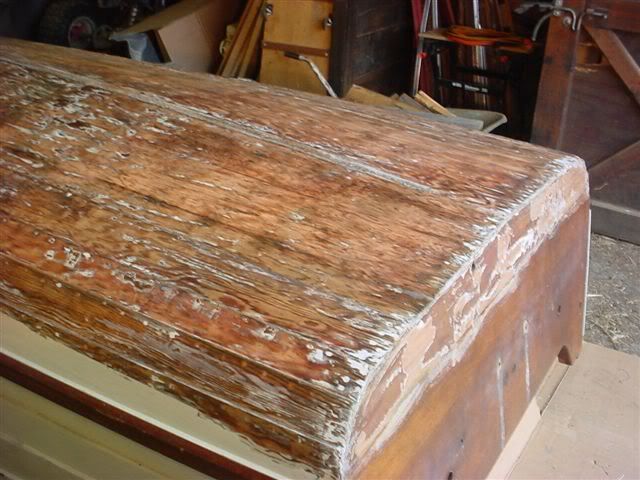
It would have probably took it all off the first time if I would have been more careful to make sure there was an even coat of stripper applied. Even though we weren't creating dust, we were wearing gloves, face shields, and respirators just in case. I also collected the stripped paint and put it into an empty 5-gal bucket for proper disposal.
The topside paint was a 20-yr old two-part epoxy. I hadn't planned on removing it because I thought it would be too hard. However, some Citristrip did get on it and stripped it off even easier than the bottom paint. When I saw that i decided to strip it off also. I applied the Citristrip with a 3" roller and a brush for the lapstrake seams. It's important to cover the Citristrip with paper or plastic (I used a plastic $2.50 drop cloth that was 10x20 feet from Home Depot) so it doesn't evaporate instead of attacking the paint.
Here it is as it sits now with Citristrip on the topside white paint:
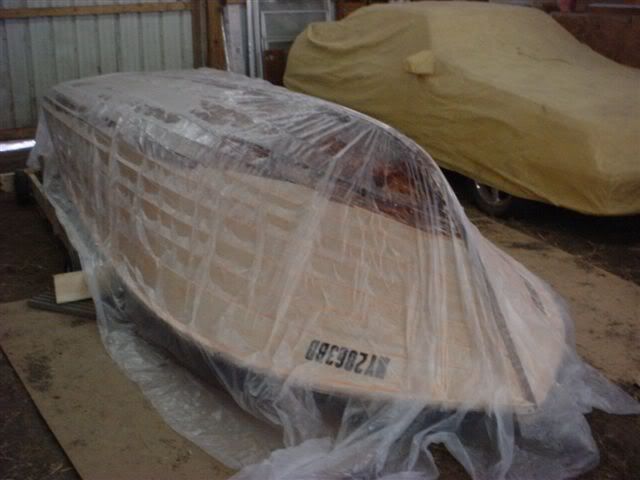
You can see the orange tint of the Citristrip.
Steve
Posted: Wed May 12, 2010 8:55 am
by 240sxguy
Nice work!
I used citristrip on the topside with great results, and plan on using it for the sides and bottom as well.
Posted: Wed May 12, 2010 6:26 pm
by john
Steve
Was in your shoes back in 2003 with my 1960 16' Cruiser's 202.
Instead of scrafting ribs, I constructed a new inner keel 2' wider and cut off the ribs ends about 1". worked very well.
I found it so easy to remove the garwood, I ended up removing all the lapstrats except the top. I even disassembled the transom, reglued and reassembled with new screws.
All lapstrakes were reused using new screws.
Advantage was that I was able to complety strip both sides of the lapsrakes. I cpes and revarnished the inside of each lapstrakes before reassembly. I also was able to cpes and varnish the ribs of the lapstrake side, they were raw wood for the factory.
Hull was reassembled using silicon brass srews and 5200, 6 years, 150 hours and 8000 miles of trailering, boat does not leak a drop.
www.aerialimaging.net/john
email me @
jplatou10@verizon.net and I will give you my cell number, if I can help you in anyway. cell phone has unlimited nation wide minutes.
Posted: Thu May 13, 2010 4:48 am
by 240sxguy
John, I am going to start a new thread about your boat. Please reply whenever you get a chance.
Posted: Sat May 15, 2010 4:10 am
by 62cruiserinc
We finished stripping the paint off the hull yesterday. It came off pretty easily, a few small spots required harder scraping with the pull scraper. Here's a picture:
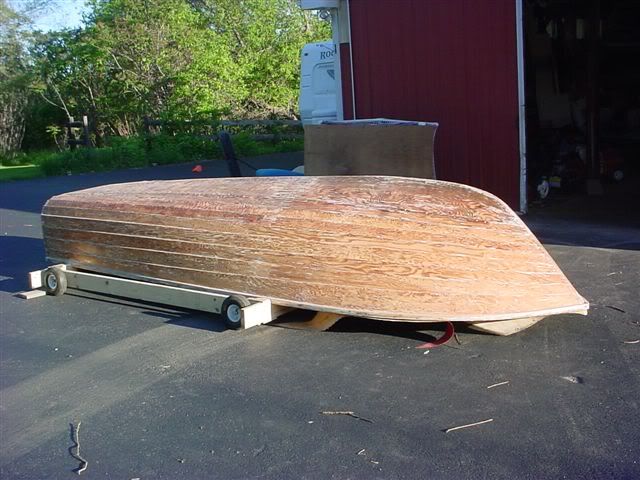
Now the next step is to remove the putty from the screw heads to expose the screws.
I was only going to remove the garboards, but John Platou convinced me to at least remove the lapstrakes that are below the waterline to reseal them. I was surprised to hear that the side of the ribs facing the lapstrakes is not finished from the factory, it's just raw wood!
The plan is to:
1. remove the garboards and most of the lapstrakes
2. strip the remaining varnish off the inside of the lapstrakes and the ribs
3. cut the ends off the ribs about 1"
4. scarf in new sections on any weak ribs
5. remove the transom to fix a small rotted spot and reglue the lamination
6. make a new, wider, stronger keel to accommodate the shorter ribs
7. fix the short section of inner stem that is rotted
8. coat everything with CPES
9. replace the transom, lapstrakes, and keel
10. make a new outer keel and outer stem (steam-bending)
11. paint and varnish
12. enjoy boat (I'll keep looking at this one to remind me that it's worth it!)
I'll post pictures of each step of the project and anyone can feel free to offer suggestions or critiques as I go along.
Steve
Posted: Sat May 15, 2010 5:53 am
by 240sxguy
Nice man, I totally agree. After looking at Johns pictures and getting a few details it seems like the logical way to do things.
Keep up the good work, you have me itching to start working on mine now.
Evan
Posted: Sat May 15, 2010 11:52 am
by LancerBoy
These boats were made in assembly line type production, thousands each year. Cruisers, Inc. made about 3,000 boats annually at their peak. Thompson Bros. Boat Mfg. Co. at Peshtigo made up to 8,000 in one year at her peak. 5,000 annually was normal. They slapped 'em together and got 'em out the door. The expected life span of a boat was 6 to 10 years.
It is a miracle that any of us have vintage boats today.
No way was a boat builder going to cut out all the components, seal or varnish them and then assemble the parts. Finishes were sprayed on after the boat was all assembled. Three coats of vanish at most and probably one prime coat of paint and one top coat.
Andreas
Posted: Wed May 19, 2010 3:50 am
by 62cruiserinc
I removed one of the garboards last night.
Here's the garboard in the process of removal:
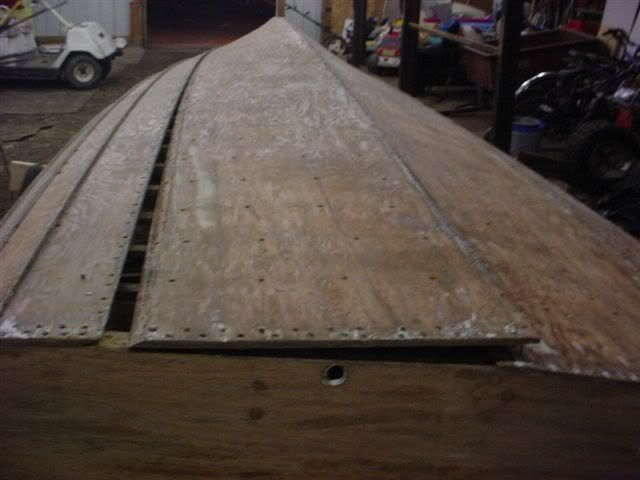
A picture with the garboard off:
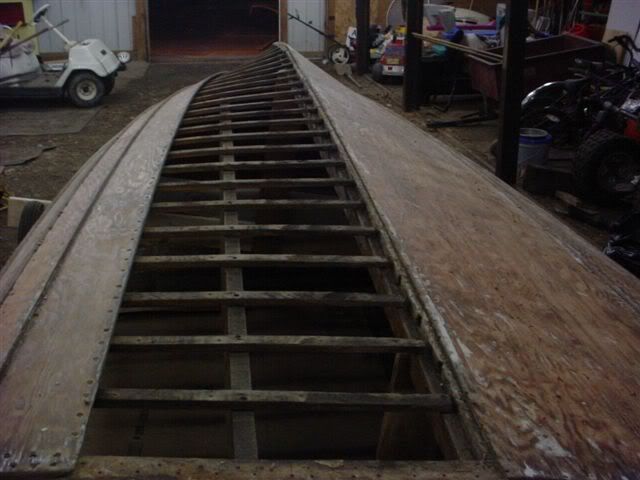
I used a hollow puch just larger than the screw head diameter to get the putty out.
There was one surprise- The garboard was nailed to the ribs at the lower end at the first 6 or 7 ribs at the bow end. These nails were under the overlap, which meant I could not slide it out from under the first lapstrake. My solution was to pull up the garboard at the keel and use a long chisel to slice off the nail between the garboard and rib. Otherwise, things went pretty well. It took me and my son about 2 hours to remove the garboard. Using our experience with the first one, the second should take less time.
More pictures coming as we go along.
Steve





